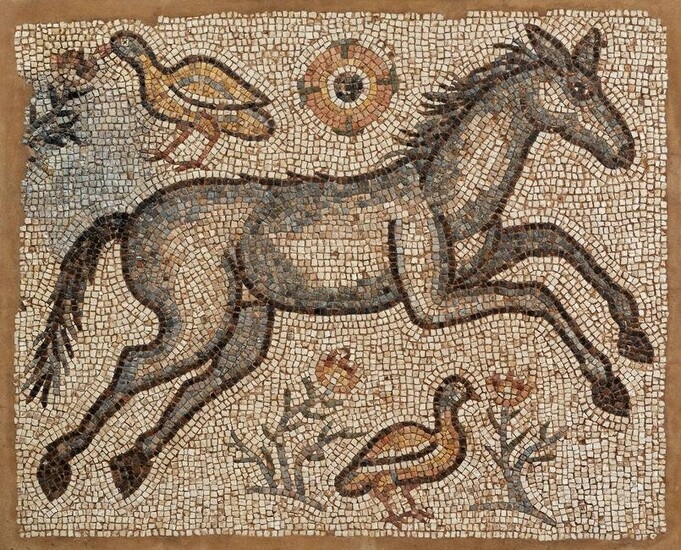Roman mosaic from the 2nd century AD. Opus tessellatum.
Roman mosaic from the 2nd century AD.
Opus tessellatum.
Size: 105 x 127 cm; 116 x 141 cm (frame).
A large Roman mosaic, dated to the 2nd century, depicting a donkey in movement, set in a landscape insinuated by floral buds among birds and a sun at the zenith. This is a common type of representation on the floors of the main rooms of Roman villas. With great delicacy, silver and amber colours are combined to give a certain sense of volume to the bodies. The art of mosaic came to Rome from Greece, and soon became a major industry, reaching previously unseen heights of quality. It became so widespread that it became the main decoration of any Roman villa or house. In Rome, mosaics were made from small pieces called tesserae (hence the name 'opus tessellatum'), cube-shaped pieces of calcareous rock, glass or ceramic of different sizes. These tesserae were arranged on the surface to be decorated like a jigsaw puzzle, distributing the colour and shape according to the design, and fixed with cement. The importance of mosaic manufacture is demonstrated by events such as the facilities granted by Constantine to the mosaicists in 330 when he moved the capital from Byzantium, encouraging the exodus of Greek and Roman masters to the new capital, thus laying the foundations for the famous Byzantine mosaic.
Sale price
Estimate
Time, Location
Auction House
Roman mosaic from the 2nd century AD.
Opus tessellatum.
Size: 105 x 127 cm; 116 x 141 cm (frame).
A large Roman mosaic, dated to the 2nd century, depicting a donkey in movement, set in a landscape insinuated by floral buds among birds and a sun at the zenith. This is a common type of representation on the floors of the main rooms of Roman villas. With great delicacy, silver and amber colours are combined to give a certain sense of volume to the bodies. The art of mosaic came to Rome from Greece, and soon became a major industry, reaching previously unseen heights of quality. It became so widespread that it became the main decoration of any Roman villa or house. In Rome, mosaics were made from small pieces called tesserae (hence the name 'opus tessellatum'), cube-shaped pieces of calcareous rock, glass or ceramic of different sizes. These tesserae were arranged on the surface to be decorated like a jigsaw puzzle, distributing the colour and shape according to the design, and fixed with cement. The importance of mosaic manufacture is demonstrated by events such as the facilities granted by Constantine to the mosaicists in 330 when he moved the capital from Byzantium, encouraging the exodus of Greek and Roman masters to the new capital, thus laying the foundations for the famous Byzantine mosaic.



